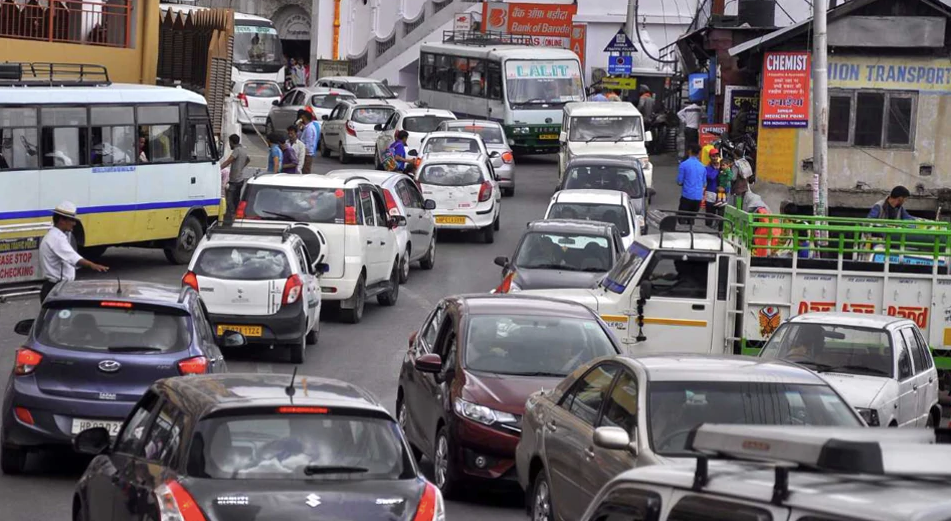Ensconced in my tiny village near Mashobra in the Shimla hills, these days I feel like Raja Hari Singh Katoch of Kangra when he was besieged in the Kangra fort by Jahangir in 1620. Worse, actually, because the stalwart Raja had to put up with the inconvenience for only fourteen months whereas I have had to endure it every year. And it’s not the Mughal army I have to contend with but the Khan Market and Lutyen’s gangs of Delhi.
Come April every year and members of these gangs, in the tens of thousands, clamber up the mountain landscape and take over our roads, markets, forests and every bed in every homestead. Like locusts they devour everything and leave behind in their wake tonnes of plastic, bottles, empty packets of chips, cigarettes and condoms. Like Jahangir, they lay claim to our lawns, apple trees and parking places; the women have been spared so far, but that’s only because we hide them with the cattle. We huddle in our houses, waiting for the pestilence- called tourists in modern parlance- to pass.

My grandfather, a patriarch no one messed with, stayed in a village of Fatehpur district in UP called Husainganj (unless the good Yogi has now changed its name). He had built himself a huge haveli there and inscribed one golden rule in its stones: all his children and 17 grandkids had to visit him every summer: he even paid for the rail tickets. So I never even saw a mountain (or sea, or desert) till I was 25: every summer vacation my Dad would pack the family into a second class coach of the Kalka mail at Calcutta (or Hazaribagh or Asansol or wherever he happened to be posted at the time) for the 24 hour journey to Fatehpur- annual migrations one looks back on with fond nostalgia mixed with a regret that my own sons (part of the KM gang) have never seen this facet of the Old India. For today train travel is all about getting to the destination as quickly as possible, it’s never about the pleasures of the journey itself. I recently travelled by Shatabdi to Kanpur and found that of the 62 passengers, 60 of them had buried their persona and noses into their smart phones. The 61st was a seven eight year old kid (who should have been smothered at birth) who was sliding the door open and shut, letting in the flies and letting out the cold air. I was the 62nd, observing it all and weeping like Alexander the Great for I had now seen it all.
For us the journey was itself a delight. There were no AC coaches or electric traction back then. We would stick our heads out of the open windows, breathing in the soot and smoke from the Bullet engines, jump out at every station to buy comics from the AH Wheeler stalls (where have they all disappeared?), grab the local station food from the vendors- “jhalmoori” at Asansol, aloo tikkis at Dhanbad, samosas at Mughalsarai, puri-aloo at Benaras, the delicious pedas at Allahabad. All extremely unhygienic, swarming with e-colis no doubt, but Michelin star stuff which built up the immunity which in later years has enabled us to tackle the tasteless swill IRCTC serves on trains nowadays. But the “piece de resistance” for which we all used to wait, came at Fatehpur, which arrived at the opportune time for breakfast. Its generally deserted restaurant served the best buttered toast and omelette on the Grand Trunk line, on round tables covered with spotless linen and cutlery. (The only railway restaurant that comes even close to its ambience and service is the Barog station on the Kalka-Shimla line). We left the restaurant only when they ran out of eggs, for the next two weeks in Husainganj was to be a vegetarian existence, without even onions and garlic.

He is gone now, of course, and so is the world we grew up in: the haveli is in ruins, the bullock cart is now a symbol of penury, not of status, the omelette is now a leathery strip served with sarkari reluctance, the station food vendors replaced by catering franchisees hawking packaged rubbish, most trains do not even stop at Fatehpur. Why should they? Nobody goes there for everyone is now headed for the mountains, the seaside resorts or the casinos of Goa. In this world of OYO rooms, Make My Trip.com, Airbnb and cash backs, visiting grandfathers is such a waste of time. But I do wish the millennial generation would start visiting the old critters again: it would make them happy, it would lift my siege and might even save the mountains from further depredation. I speak, of course, as a grandfather-in-waiting.
| The author retired from the IAS in December 2010. A keen environmentalist and trekker he has published a book on high altitude trekking in the Himachal Himalayas: THE TRAILS LESS TRAVELLED.
His second book- SPECTRE OF CHOOR DHAR is a collection of short stories based in Himachal and was published in July 2019. His third book was released in August 2020: POLYTICKS, DEMOCKRAZY AND MUMBO JUMBO is a compilation of satirical and humorous articles on the state of our nation. His fourth book was published on 6th July 2021. Titled INDIA: THE WASTED YEARS , the book is a chronicle of missed opportunities in the last nine years. Shukla’s fifth book – THE DEPUTY COMMISSIONER’S DOG AND OTHER COLLEAGUES- was released on 12th September 2023. It portrays the lighter side of life in the IAS and in Himachal. He writes for various publications and websites on the environment, governance and social issues. He divides his time between Delhi and his cottage in a small village above Shimla. He blogs at http://avayshukla.blogspot.in/ |




Lovely article!